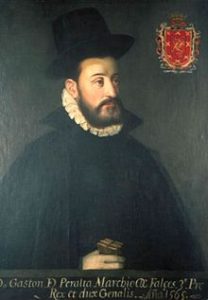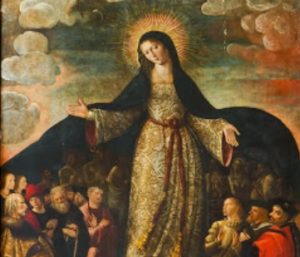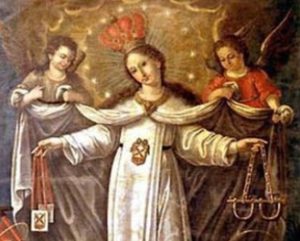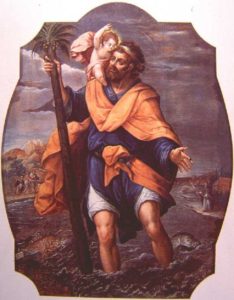Podcast: Play in new window | Download
Subscribe: Apple Podcasts | RSS
 The date was October 16, 1566 and the place was Mexico City, the colonial capital of New Spain. The Third Marquis of Falces, a man named Gastón de Peralta, had just arrived with his entourage and assumed the position of Viceroy, or the king’s official representative in the country which had been under Aztec control only 47 years earlier. King Phillip II of Spain sent the marquis to bring stability to his overseas possession after the death of the previous Viceroy Luis de Velasco and the interim rule of the Audencia. There had been unrest among newly conquered native peoples and among some of the first generation of Spaniards born in the New World who had demanded more autonomy from Spain. Among Viceroy Peralta’s entourage was a strongly built man in his mid-thirties with reddish-blond hair and very pale skin. The man was Simon Pereyns, a portrait artist who originally hailed from Antwerp in the lowland country of Flanders which was then part of the Spanish Netherlands and is now part of modern-day Belgium. At the age of 28 Pereyns had moved from Flanders to the Iberian Peninsula and settled in Lisbon where he lived a year and then moved to Toledo before moving on to Madrid. Inspired by both the style of 16th Century Roman painters and the Flemish masters of his homeland, Pereyns became a celebrated portrait painter at the Spanish Court and was said to have created 2 paintings of King Phillip II which do not survive to this day. Many of his works are lost, but Pereyn’s artistic career is well documented thanks to contracts he signed while doing his noble portrait commissions. He is sometimes seen in the contract records as “Perin” or even the Hispanicized “Pérez.” After painting portraits of members of the family of the future Viceroy Peralta, Pereyns was encouraged to accompany the marquis to Mexico City as part of his official retinue. Simon Pereyns accepted and become the first European portrait artist to take up residence in Mexico.
The date was October 16, 1566 and the place was Mexico City, the colonial capital of New Spain. The Third Marquis of Falces, a man named Gastón de Peralta, had just arrived with his entourage and assumed the position of Viceroy, or the king’s official representative in the country which had been under Aztec control only 47 years earlier. King Phillip II of Spain sent the marquis to bring stability to his overseas possession after the death of the previous Viceroy Luis de Velasco and the interim rule of the Audencia. There had been unrest among newly conquered native peoples and among some of the first generation of Spaniards born in the New World who had demanded more autonomy from Spain. Among Viceroy Peralta’s entourage was a strongly built man in his mid-thirties with reddish-blond hair and very pale skin. The man was Simon Pereyns, a portrait artist who originally hailed from Antwerp in the lowland country of Flanders which was then part of the Spanish Netherlands and is now part of modern-day Belgium. At the age of 28 Pereyns had moved from Flanders to the Iberian Peninsula and settled in Lisbon where he lived a year and then moved to Toledo before moving on to Madrid. Inspired by both the style of 16th Century Roman painters and the Flemish masters of his homeland, Pereyns became a celebrated portrait painter at the Spanish Court and was said to have created 2 paintings of King Phillip II which do not survive to this day. Many of his works are lost, but Pereyn’s artistic career is well documented thanks to contracts he signed while doing his noble portrait commissions. He is sometimes seen in the contract records as “Perin” or even the Hispanicized “Pérez.” After painting portraits of members of the family of the future Viceroy Peralta, Pereyns was encouraged to accompany the marquis to Mexico City as part of his official retinue. Simon Pereyns accepted and become the first European portrait artist to take up residence in Mexico.
 Simon Pereyns enjoyed great success in colonial Mexico City. As the lone European-trained portrait artist in the capital city, he was never at a loss for work or the sponsorship of wealthy patrons. One of his backers was Francisco de Morales, a man known for his lavish banquets and parties. At one of Morales’ parties an interesting topic of conversation arose. The Archbishop of Mexico, Alonso de Montúfar, had announced a contest connected with the main cathedral of Mexico City which was still under construction. The contest called on all the artists of New Spain to create a portrait of the Virgin Mary for the cathedral’s new Altar del Perdón, or Altar of Forgiveness. The Virgin would be called Our Lady of Forgiveness, or the Virgin of Forgiveness. When asked if he would participate in the contest, Pereyns waved his hand in a dismissive manner and told Francisco de Morales that he didn’t want to waste his time on painting religious pictures when there was real money to be made in painting portraits of the family members of people of high station in Mexico City. The comment was overheard by many and was considered blasphemous. Pereyns had thought himself so above creating paintings with religious themes that it almost seemed as if he was mocking the Church. As Simon Pereyns had enjoyed a good life in Mexico City and commanded a high premium for his works, there were many people who were jealous of him and eager to either witness or actively participate in his downfall. His comments at the party had given his enemies the ammunition to take him down. Not only were there rumors around the city that Pereyns was a blasphemer, others came forward alleging that Pereyns had partaken in scandalous gossip of a more private nature. There were also stories circulating around Mexico City that Simon Pereyns was secretly a Jew.
Simon Pereyns enjoyed great success in colonial Mexico City. As the lone European-trained portrait artist in the capital city, he was never at a loss for work or the sponsorship of wealthy patrons. One of his backers was Francisco de Morales, a man known for his lavish banquets and parties. At one of Morales’ parties an interesting topic of conversation arose. The Archbishop of Mexico, Alonso de Montúfar, had announced a contest connected with the main cathedral of Mexico City which was still under construction. The contest called on all the artists of New Spain to create a portrait of the Virgin Mary for the cathedral’s new Altar del Perdón, or Altar of Forgiveness. The Virgin would be called Our Lady of Forgiveness, or the Virgin of Forgiveness. When asked if he would participate in the contest, Pereyns waved his hand in a dismissive manner and told Francisco de Morales that he didn’t want to waste his time on painting religious pictures when there was real money to be made in painting portraits of the family members of people of high station in Mexico City. The comment was overheard by many and was considered blasphemous. Pereyns had thought himself so above creating paintings with religious themes that it almost seemed as if he was mocking the Church. As Simon Pereyns had enjoyed a good life in Mexico City and commanded a high premium for his works, there were many people who were jealous of him and eager to either witness or actively participate in his downfall. His comments at the party had given his enemies the ammunition to take him down. Not only were there rumors around the city that Pereyns was a blasphemer, others came forward alleging that Pereyns had partaken in scandalous gossip of a more private nature. There were also stories circulating around Mexico City that Simon Pereyns was secretly a Jew.
 In the 1560s in Mexico City, the formal Holy Office of the Spanish Inquisition did not yet exist, although the functions of the Inquisition did, in the office of the Archbishop of Mexico. The purpose of the Inquisition was to root out heretics and punish those who went against the Catholic Church in word or deed. Pereyns’ comments at the Morales party and rumors of his secret practice of the Jewish faith were enough cause to bring him before Archbishop Alonso de Montúfar. On September 10, 1568 he forcibly “confessed” his blasphemy before a Dominican brother and 4 days later was examined formally. In the initial rounds of questioning, it was discovered that while Pereyns was not the most faithful Christian in Mexico City and almost never made confession or attended mass, he was not a Jew. To his off-the-cuff comments of being too good to paint religious pictures, this was another matter. For these comments he was to be punished, even tortured. The archbishop’s preferred method was to put those examined on a rack and have water slowly dripped into their mouths from a linen rag. Simon Pereyn had this done to him three times and the questioning and imprisonment lasted for months. It seems like nothing Pereyns could do would please the church authorities. Apparently, during his brief time in Mexico City, Pereyns had angered many people with his holier-than-thou attitude and many delighted to hear he was punished so harshly. Some were even calling for him to be burned at the stake.
In the 1560s in Mexico City, the formal Holy Office of the Spanish Inquisition did not yet exist, although the functions of the Inquisition did, in the office of the Archbishop of Mexico. The purpose of the Inquisition was to root out heretics and punish those who went against the Catholic Church in word or deed. Pereyns’ comments at the Morales party and rumors of his secret practice of the Jewish faith were enough cause to bring him before Archbishop Alonso de Montúfar. On September 10, 1568 he forcibly “confessed” his blasphemy before a Dominican brother and 4 days later was examined formally. In the initial rounds of questioning, it was discovered that while Pereyns was not the most faithful Christian in Mexico City and almost never made confession or attended mass, he was not a Jew. To his off-the-cuff comments of being too good to paint religious pictures, this was another matter. For these comments he was to be punished, even tortured. The archbishop’s preferred method was to put those examined on a rack and have water slowly dripped into their mouths from a linen rag. Simon Pereyn had this done to him three times and the questioning and imprisonment lasted for months. It seems like nothing Pereyns could do would please the church authorities. Apparently, during his brief time in Mexico City, Pereyns had angered many people with his holier-than-thou attitude and many delighted to hear he was punished so harshly. Some were even calling for him to be burned at the stake.
Sometime in December of 1568, Simon Pereyns was returned to his jail cell after a long session with the inquisitors. While lying on his back, trying to fall asleep, a shimmering light began to glow in his cell. His quarters also began to fill with a sweet fragrance of spring flowers. The glow became much brighter which caused the dejected and demoralized artist to sit up. He then watched the light turn into a beautiful figure. It was an apparition of the Virgin Mary known as Our Lady of Mercy, and for a few moments she looked upon Pereyns with gentle eyes which had an element of sadness to them.
“Little son, why do you not love me?” The Virgin asked in a soothing voice.
Pereyns immediately got up and knelt before the blazing apparition which was described as brighter than sunlight. “Queen of Heaven,” he began, “I love you with all of my heart and soul. Please deliver me from this place.”
With a gentle smile, the Virgin slowly faded away and the light became dimmer. The heavenly perfume that once filled the room had gone. The only light left in Pereyns’ cell was the light of the moon. In the moonlight the artist saw something that the Virgin had left behind: paints, brushes and colors in chalk. The artist’s task was clear: Pereyns would give up his personal aversion to painting religious-themed art and would get to work on the back of the prison cell door with the materials at hand. By the first light of morning Pereyns had painted the likeness of the Virgin who had visited him that previous night. He used all the colors left behind and the painting seemed to radiate its own special luminescence. Pereyns called a jailer to see his work, and thinking the Flemish artists was playing a trick, two other jailers entered the cell. The painting was so marvelous, they dropped to their knees. There was no explaining how the artist had crafted such a work with no materials and so little time. The jail authorities called for the Archbishop who came immediately. During a brief conversation, Pereyns told the archbishop that he would paint the Virgin for the cathedral and would not accept the prize money. The archbishop entertained Pereyns’ offer and let him go. Simon Pereyns painted the painting which occupied the  place over the Altar of Forgiveness in the Mexico City Cathedral for many years. Like so many of Pereyns’ works, the Virgin of Forgiveness remains lost. Some say it was destroyed in a fire sometime in the 1960s, but other sources cite that it was gone a long time before that. After he painted the virgin for the cathedral Simon Pereyns, who was now in the good graces of the people of Mexico City, settled down and got married. He also continued painting religious-themed works. The few that survive include a painting of Saint Christopher and what is considered his most important work: the main altarpiece of the Monastery of Huejotzingo, which includes 6 painted panels depicting the life of Christ. Pereyns’ style was said to have influenced other Mexican-born artists well into the 17th Century.
place over the Altar of Forgiveness in the Mexico City Cathedral for many years. Like so many of Pereyns’ works, the Virgin of Forgiveness remains lost. Some say it was destroyed in a fire sometime in the 1960s, but other sources cite that it was gone a long time before that. After he painted the virgin for the cathedral Simon Pereyns, who was now in the good graces of the people of Mexico City, settled down and got married. He also continued painting religious-themed works. The few that survive include a painting of Saint Christopher and what is considered his most important work: the main altarpiece of the Monastery of Huejotzingo, which includes 6 painted panels depicting the life of Christ. Pereyns’ style was said to have influenced other Mexican-born artists well into the 17th Century.
As with other stories of miracles or fantastic claims, researchers are quick to look for proof. In the ecclesiastical records of colonial Mexico City, there is documentation in the archives of the Inquisition of what happened to Pereyns. There exists a parchment signed by a “Doctor Estevan de Portillo,” who was listed as Pereyns’ inquisitor, that lists the artist’s punishment for blasphemy. Translated into English, it reads:
“On the acts and merits of this case it is found that for the crime committed I condemn him to paint at his own cost an altar-piece of Our Lady of Mercy for the Holy Church (the Cathedral) very devout and to me pleasing, and that in the interim while he is painting this altar-piece he shall not leave this city under penalty of being punished with all the rigor as one disobedient to the mandates of the Holy Office, and I admonish and command that said Simon Pereyns that from this time forth he shall not speak such words as those for the speaking of which he has been arrested, nor shall he question any matters touching our holy Catholic faith under penalty of being rigorously punished.”
Although there is no documented evidence of the miracle of the appearance of Our Lady of Mercy in Pereyns’ jail cell, one must wonder what compelled the stubborn artist to change his mind and submit to authorities. Was he simply worn down by the Inquisition or was he genuinely touched by the divine?
REFERENCES
Janvier, Thomas A. Legends of the City of Mexico. New York: Harper and Brothers Publishers, 1910.
“Simon Pereyns” from the Biografías y vidas website (in Spanish)

3 thoughts on “The Miracle of the Virgin of Forgiveness”
Dear Robert,
So great to hear your voice and your story..so enjoyed the spoken version–well done Robert!
Thank you, Jill Heflin
Thank you Jill! Glad you enjoyed it. There are 100+ shows in audio on here now.
Thank you so much Chris(sy)!!!